Rosewood and its destruction did not exist in a vacuum. It was part of a much larger history of racial violence in American history. These connections with local, regional, and national trends resonates across time and space. Today, Americans of all backgrounds need to develop an awareness of this historical context in order to fully understand the importance of Rosewood and related events.
The 1923 Rosewood massacre occurred during Jim Crow. It occurred during a particularly violent period following World War I when race riots gripped dozens of towns during the Red Summer of 1919 alone. In Florida alone, race riots in Ocoee and Perry were part of a much longer tradition of anti-Black violence in the state, where more African Americans were lynched than any other southern state. The media contributed to this violence by representing African Americans as deviant and dangerous (e.g., Birth of a Nation) while leaders of the eugenics movement re-wrote US immigration policy in 1924, of which several parts survive to this day.

The country increasingly came under the influence of irrational, labor-hostile forms of businesses and government agencies. Understanding how these changing trends interacted at various scales provides a deeper analytical framework for understanding the riot in Rosewood. Ultimately, it was an intersection of various forms of violence which drove events like the destruction of Rosewood.
Social scientists regularly differentiate violence into interpersonal, symbolic, and structural forms. Interpersonal forms refer to face-to-face violence (e.g., lynching), symbolic forms refer to cultural and social attitudes (e.g., media), and structural violence describes the social inequality that disenfranchises minority communities through various means. These different types were in flux during the early 20th century. Since the destruction of Rosewood, America has witnessed an inversion whereby symbolic and structural forms surpassed interpersonal forms as the dominate methods for halting minority advancement. Prior to this, many White communities resorted to interpersonal violence at the slightest perceived affront. As the trends changed, White attitudes turned an increasingly blind eye as social institutions (e.g., incarceration) unfairly punishing minorities who were seen as not conforming.
The research for this site is dedicated to investigating the intersection of these forms of violence in the past and present. A central goal is the articulation of how past racial violence resonates across time and space to inform modern social inequality. This project also seeks to build a better tomorrow by encouraging a sensitive approach inviting descendants, landowners, and the public into a conversation on reconciliation in the present. This includes discussing reparations.
Return to previous section: History of the 1923 Rosewood violence.
Continue to the next section: Redress and Reparations.